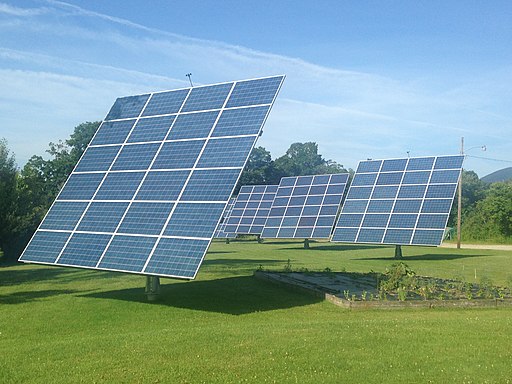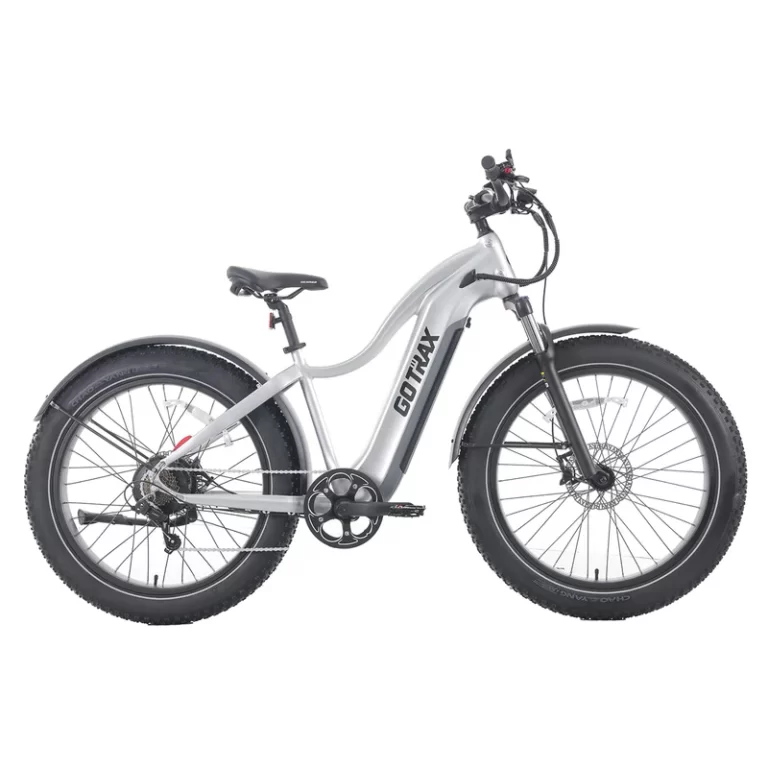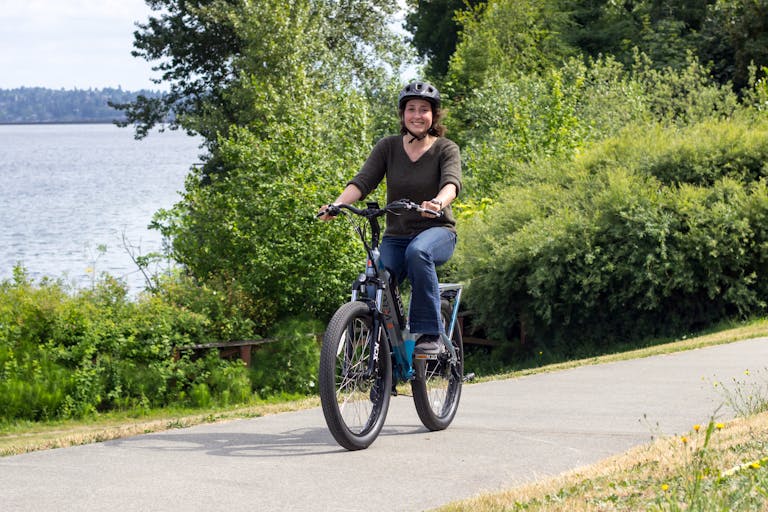Solar Power on the Go: DIY E-Bike Charging Solutions
Last Updated on June 24, 2024 by Kristina Grant
E-bikes are rapidly transforming the way we commute and explore. Their combination of pedal-assist and electric power offers a convenient, eco-friendly, and enjoyable riding experience. Whether you’re cruising through city streets, tackling off-road trails, or embarking on long-distance adventures, e-bikes open up a world of possibilities.
However, for many e-bikers, a common concern arises: range anxiety. E-bikes rely on rechargeable batteries, and depending on the battery capacity and terrain, range can be limited. While public charging stations are becoming more widespread, they might not always be readily available, especially on remote adventures or scenic detours. This is where the concept of DIY solar e-bike charging comes in.
Harnessing the power of the sun, DIY solar e-bike charging solutions offer a sustainable and empowering way to keep your e-bike juiced up for those extended journeys. Imagine exploring breathtaking landscapes or secluded campsites without the worry of finding a wall outlet. By building your own solar charging system, you can achieve off-grid charging, reduce your reliance on the traditional grid, and contribute to a greener future. This blog post will delve into the exciting world of DIY solar e-bike charging, guiding you through the options available, the factors to consider, and the steps to get you started on your path to solar-powered e-bike adventures.
Key Takeaways
- Sustainable & Cost-Effective: Embrace the power of the sun! DIY solar charging offers a sustainable way to fuel your e-bike adventures, reducing reliance on the grid and minimizing your carbon footprint. Over time, this translates to significant cost savings on electricity bills, especially for frequent riders.
- Portable or Permanent: The beauty lies in choice. Portable solar panels offer ultimate flexibility for on-the-go charging, perfect for day trips or weekend getaways. For those seeking a more permanent solution, integrated solar bike rack systems provide a convenient way to charge your e-bike while parked.
- Matching the System: Efficiency is key. Choosing the right solar panel wattage for your e-bike battery voltage and desired charging speed is crucial. Similarly, selecting a compatible solar controller with features like overcharging protection ensures safe and efficient operation of your solar charging system.
- Charge Time Considerations: Solar power is clean and renewable, but patience is a virtue. Charging times depend on various factors like solar panel wattage, battery capacity, and sunlight intensity. While solar panels might not fully charge your battery during short rides, they can provide a significant top-up for extended adventures.
- Riding While Charging – Reality Check: The concept of solar charging while riding your e-bike is intriguing, but current technology has limitations. Portable solar panels typically cannot generate enough power to keep pace with your e-bike’s motor consumption. Additionally, inconsistent sunlight exposure makes consistent charging while riding impractical.
- Folding Panels for Camping Freedom: For e-bikers who love exploring off-the-grid destinations, folding solar panels are a must-have. These lightweight and compact power plants offer portability and ease of storage, allowing you to conveniently charge your e-bike and other devices during camping trips.
- Embrace the Journey: DIY solar e-bike charging might require some research and planning, but the rewards are truly fulfilling. The satisfaction of achieving self-sufficient and eco-friendly e-bike adventures powered by the sun is a journey worth taking. With careful planning and the knowledge gleaned from this post, you can embark on your solar-powered e-bike odyssey!
The Benefits of Solar E-Bike Charging
As e-bikes continue to gain momentum, so too does the desire for sustainable and eco-friendly ways to keep them charged. This is where DIY solar e-bike charging solutions shine. Here’s how you can benefit from embracing the power of the sun:
- Cost-effective: E-bikes offer significant cost savings compared to gas-powered vehicles. Solar charging takes this a step further by allowing you to harness the free energy of the sun to power your e-bike. Over time, this translates to significant savings on electricity bills, especially if you’re a frequent rider. Imagine pedaling past gas stations with a smile, knowing your e-bike is fueled by the sun’s rays.
- Environmentally friendly: By choosing solar power, you’re actively reducing your reliance on fossil fuels and minimizing your carbon footprint. E-bikes are already a clean transportation option, and solar charging eliminates the environmental impact associated with traditional electricity generation. This makes every ride a contribution to a cleaner, greener future.
In addition to these core benefits, solar e-bike charging offers a sense of self-sufficiency and independence from the grid. Imagine the freedom of exploring remote areas or embarking on extended camping trips without worrying about finding an outlet. With a properly sized solar charging system, you can enjoy the peace of mind of knowing you can recharge your e-bike practically anywhere there’s sunlight.
RELATED CONTENT – Charging Your Ebike with a Power Bank
RELATED CONTENT – On the Go Strategies for Charging an Ebike While Traveling
Self-Sufficiency and Scalability: Unleashing Your E-Bike’s Potential
One of the most exciting aspects of DIY solar e-bike charging is the freedom it offers. Forget about range anxiety and the limitations of finding a charging station. Solar power unlocks the true potential of your e-bike, transforming it into a truly off-grid companion:
- Off-Grid Charging: Imagine the possibilities! With a solar charging system, you can conquer remote trails, embark on epic camping adventures, or explore hidden gems far from the beaten path. As long as there’s sunshine, you have a reliable way to recharge your e-bike battery. This opens doors to experiences that might otherwise be limited by dependence on the traditional grid.
- Scalability: Beauty lies in customization. The beauty of DIY solar e-bike charging is that you can tailor the system to your specific needs. E-bikes come with varying battery voltages, and your desired charging speed will also play a role. The good news is that solar charging systems are scalable. You can choose a portable solar panel kit that offers a convenient charging solution for shorter trips. For longer adventures or those who crave faster charging times, you can opt for a more powerful solar panel setup. By carefully considering your e-bike’s battery voltage and your charging goals, you can create a solar charging system that perfectly complements your riding style.
Exploring DIY Solar E-Bike Charging Options
The world of DIY solar e-bike charging offers a range of exciting possibilities. Let’s delve into the different options available to you:
- Portable Solar Panels: For those who crave flexibility and convenience, portable solar panels are a perfect choice. These lightweight, foldable panels are ideal for day trips, weekend adventures, or situations where space is limited. When choosing portable solar panels, there are a few key factors to consider:
- Wattage: This refers to the amount of power a solar panel can generate. Higher wattage panels will charge your e-bike battery faster, but they will also be larger and heavier. Consider your daily riding distance and desired charging speed to determine the optimal wattage for your needs.
- Size and Weight: Portability is a key advantage, so be mindful of the panel’s size and weight when folded. You’ll want a panel that’s easy to transport and store on your e-bike or backpack.
- Foldability: Many portable solar panels fold up into a compact package for easy storage and transportation. Look for panels with a sturdy folding mechanism and a carrying case for added protection.
Finding the perfect portable solar panel kit for your e-bike is easy! Online marketplaces offer a wide variety of options, including specific kits designed for portable solar panel kit for 48v ebike and DIY solar charger for 36v ebike battery. By researching and comparing features, you can find a portable solar panel that seamlessly integrates with your e-bike and charging needs.
In the next section, we’ll explore the exciting world of building your own solar charger system, offering even greater customization and control over your off-grid charging experience.
RELATED CONTENT – Complete Guide to Electric Bike Charging: Tips, Tricks & Best Practices
RELATED CONTENT – No More Dead Phones: Unleash the Power of the Dynamo Power Hub
Building a Solar Charger: Unleash Your Inner Engineer
For the DIY enthusiasts and those who crave a more customized solution, building your own solar charger system offers a rewarding and empowering experience. Here’s a glimpse into the components and basic considerations involved:
- The Essentials: To build your own solar charger, you’ll need a few key elements:
- Solar Panel: This is the heart of your system, converting sunlight into electricity. The choice of solar panel will depend on your e-bike’s battery voltage and your desired charging speed.
- Solar Controller: This acts as the brain of the system, regulating the flow of electricity from the solar panel to your e-bike battery. It ensures safe and efficient charging by preventing overcharging and damage to your battery.
- Cables and Connectors: These connect the various components of your system – solar panel, controller, and battery – ensuring a smooth flow of electricity.
- Wiring Considerations: While the specific wiring configuration will vary depending on your chosen components, some basic principles apply. It’s crucial to ensure proper voltage and amperage compatibility between the solar panel, controller, and battery. Using the correct cable gauge and connectors is essential for safe and efficient operation.
Building your own solar charger system might sound daunting, but fear not! There are a wealth of online resources available to guide you through the process. Websites like this one provide some instructions.
Remember, safety is paramount when working with electrical components. If you’re unsure about any aspect of the build process, it’s always best to consult with a qualified electrician or refer to detailed online tutorials. The next sections will explore additional considerations and answer some frequently asked questions to help you navigate the exciting world of DIY solar e-bike charging.
RELATED CONTENT – Charge Like a Pro: Eco Friendly Ebike Hacks You Need to Know
RELATED CONTENT – Why Does My Ebike Keep Cutting Out?
Solar Bike Rack Integration: Power on the Move
For those who crave a more permanent and convenient charging solution, integrating solar panels directly into your e-bike rack is an exciting option. This semi-permanent setup offers several advantages:
- Convenience: Imagine rolling up to your destination and having your e-bike automatically begin charging through the integrated solar panels. This eliminates the need to set up and disassemble portable panels, saving you time and effort.
- Increased Charging Efficiency: Compared to portable panels that may lie flat, integrating solar panels into your rack allows for a more optimal angle towards the sun. This can lead to improved charging efficiency, especially during midday when the sun is directly overhead.
- Aesthetics: With careful design and integration, solar panels on your e-bike rack can add a sleek and futuristic touch to your ride. It becomes a statement piece, showcasing your commitment to sustainable e-bike travel.
However, integrating solar panels into your e-bike rack requires careful planning and consideration:
- Weight and Size: Solar panels add weight to your e-bike, which can affect its handling. Ensure the rack is designed to support the additional weight of the panels without compromising stability.
- Customization: This solution might require some customization to your existing e-bike rack or the purchase of a specialized rack designed for solar integration.
- Theft Prevention: While mounted to your e-bike, the solar panels become more susceptible to theft. Consider incorporating locking mechanisms or using quick-release mounts that allow for easy removal when parked.
While integrating solar panels into your e-bike rack might require a bit more effort and planning compared to portable solutions, the benefits of convenience, increased efficiency, and a unique aesthetic can be quite rewarding for dedicated e-bikers who frequently rely on solar charging. In the following sections, we’ll delve deeper into the factors you need to consider when embarking on your solar e-bike charging journey
Key Considerations for DIY Solar E-Bike Charging: Powering Your Ride the Smart Way
Before diving headfirst into the world of DIY solar e-bike charging, it’s important to consider some key factors to ensure an efficient and successful setup. Here are some crucial aspects to keep in mind:
- Matching Solar Panel Wattage: The golden rule: match the wattage of your solar panel to your e-bike battery capacity and desired charging speed. Here’s how to determine the appropriate wattage:
- Identify your e-bike battery voltage: Most common e-bike batteries range from 36 volts (V) to 48V. This information is usually printed on the battery itself.
- Calculate your battery watt-hours (Wh): Multiply the battery voltage by its amp-hour (Ah) rating. For example, a 48V, 10Ah battery would have a capacity of 48V x 10Ah = 480Wh.
- Estimate your daily riding needs: Consider the average distance you typically cover on a single charge.
- Choose a solar panel with sufficient wattage: There’s no one-size-fits-all answer, but a general rule of thumb is to select a solar panel with a wattage rating that’s at least half your battery’s Wh capacity. This ensures a good balance between charging time and portability (for portable panels). For example, for the 480Wh battery mentioned earlier, a 240W solar panel would be a good starting point.
Remember, this is a simplified approach. You can find more detailed guides and calculators online to determine the optimal wattage for your specific needs.
- Charging Time: Patience is a virtue when it comes to solar charging. Unlike plugging your e-bike into the grid, solar charging times will vary depending on several factors:
- Solar panel wattage: Higher wattage panels will naturally charge your battery faster.
- Battery capacity: Larger batteries (more Wh) will take longer to charge compared to smaller ones.
- Sunlight intensity: Direct sunlight throughout the day translates to faster charging. Conversely, cloudy weather or shaded areas will significantly impact charging times.
By carefully considering these key factors, you can ensure that your DIY solar e-bike charging system is properly sized to meet your needs and provide a reliable off-grid charging solution for your e-bike adventures.
Keeping Your System in Check: Solar Controller Selection and Battery Care
A solar controller acts as the silent guardian of your DIY solar e-bike charging system. It plays a critical role in regulating the flow of electricity from the solar panel to your battery, ensuring safe and efficient operation. Here’s why choosing the right solar controller is essential:
- Voltage Compatibility: Just like any electrical component, your solar controller needs to be compatible with the voltage of your system. Most e-bike batteries operate between 36V and 48V. Ensure your chosen controller is rated for the same voltage as your battery to prevent damage.
- Overcharging Protection: Overcharging a battery can lead to overheating, reduced lifespan, and even potential safety hazards. A good solar controller will incorporate overcharging protection features that automatically stop the charging process when the battery reaches full capacity.
Beyond these core functionalities, some solar controllers offer additional features that can enhance your system’s performance:
- Maximum Power Point Tracking (MPPT): Traditional controllers operate at a fixed voltage. MPPT controllers constantly monitor and adjust the voltage from the solar panel to ensure it operates at its maximum power point, leading to improved charging efficiency, especially in less than ideal sunlight conditions.
Finding the perfect solar controller for your DIY e-bike charger is easy! Online retailers offer a wide variety of options, and resources like [Best solar controller for DIY ebike charger] can help you compare features and specifications to choose the controller that best suits your needs and budget.
Maintaining Battery Health: While your solar controller safeguards against overcharging, it’s also important to be mindful of your e-bike battery’s limitations. Most e-bike batteries have a recommended charging current specified in the user manual. Exceeding this current can damage the battery and reduce its lifespan. When selecting a solar controller, ensure its maximum output current doesn’t surpass the recommended charging current for your specific e-bike battery.
By prioritizing solar controller selection and maintaining proper battery care, you can guarantee a safe, efficient, and long-lasting DIY solar e-bike charging system. In the next section, we’ll address a common question regarding the practicality of solar charging while riding.
Top Solar Charge Controllers for Ebike Charging
1. Renogy Rover 40 Amp MPPT Solar Charge Controller:
- Overview: A reliable and feature-rich MPPT controller ideal for beginners and experienced DIYers alike.
- Features: MPPT technology for maximizing solar panel output, LCD display with programmable settings, error code detection for troubleshooting, multi-stage charging for optimal battery health.
- Pros: Well-built, user-friendly interface, good value for features offered.
- Cons: Larger size compared to some PWM controllers.
- Price Range: $152.99 – $179.99
- Where to Buy: Renogy
2. EPever PWM Solar Charge Controller 10A 12V/24V Automatic:
- Overview: An affordable PWM controller offering a simple and user-friendly solution for basic e-bike charging setups.
- Features: Automatic voltage and current detection, short-circuit and overload protection, temperature compensation for efficient charging in varying conditions.
- Pros: Budget-friendly, compact size, easy to install.
- Cons: PWM technology offers lower efficiency compared to MPPT controllers, limited programmability.
- Price Range: $29.99 – $39.95
- Where to Buy: Multiple retailers including ECO-WORTHY
3. Victron BlueSolar MPPT Solar Charge Controller:
- Overview: A high-quality MPPT controller from a reputable brand, known for its durability and reliability.
- Features: Advanced MPPT technology, Bluetooth connectivity for monitoring and control (requires additional Bluetooth dongle), multiple protection features, customizable settings.
- Pros: Excellent build quality, efficient charging, Bluetooth connectivity for data tracking (additional purchase required).
- Cons: Higher price point compared to other options.
- Price Range: $45.05 – $67.15
- Where to Buy: Various online retailers including Amazon
4. LiTime 60A Solar Mppt 12v/24v/36v/48v Bluetooth Charge Controller:
- Overview: A powerful MPPT controller with Bluetooth monitoring capabilities, suitable for larger solar panel setups or high-wattage e-bike batteries.
- Features: High-efficiency MPPT operation, wide voltage compatibility (12V-48V), Bluetooth connectivity for smartphone monitoring (requires app), extensive protection features.
- Pros: Handles high currents, Bluetooth monitoring, suitable for diverse battery voltages.
- Cons: Bulkier size, pricier than some options.
- Price Range: $191.99 – $269.99
- Where to Buy: Li Time website and other online retailers.
Choosing the Right Controller:
Consider these factors when selecting a solar controller for your e-bike charging system:
- Solar panel wattage and voltage: Ensure the controller’s voltage rating matches your system voltage and its amperage rating can handle the maximum current from your solar panel.
- E-bike battery voltage: The controller’s output voltage should match your e-bike battery voltage.
- Desired features: Do you need MPPT technology for efficiency or a basic PWM controller for budget-conscious setups? Bluetooth monitoring might be a valuable feature for some users.
- Budget: Solar controllers range in price depending on features and capabilities.
Remember, this is not an exhaustive list, and there are many other quality solar controllers available. By considering your specific needs and budget, you can choose the perfect controller to ensure safe, efficient, and reliable charging for your DIY solar e-bike system.
Can You Solar Charge While Riding? A Reality Check
A question that often pops up is, “Can you solar charge an ebike while riding?” While the concept is intriguing, the reality is a bit more nuanced. Technically, with a powerful enough solar panel system, it is possible to generate some electricity and provide a trickle charge to your e-bike battery while you ride. However, there are a couple of key factors that make this approach generally impractical:
- Power Disparity: E-bikes consume a significant amount of power, especially when climbing hills or maintaining speed. The wattage generated by a solar panel system suitable for portability or integration with an e-bike rack is unlikely to keep pace with the power consumption of your e-bike motor. While it might provide a slight top-up to your battery, it wouldn’t be enough to sustain your ride for extended periods.
- Sunlight Dependence: The output of a solar panel is directly dependent on sunlight intensity. If you’re riding through shaded areas, passing under trees, or encountering cloudy weather, the solar panel’s ability to generate electricity will be significantly reduced. This makes consistent charging while riding unreliable and impractical.
In essence, while solar charging your e-bike while riding holds a certain futuristic appeal, the limitations of current technology make it more of a theoretical possibility than a realistic solution for most e-bikers. However, solar charging truly shines when used for stationary charging during breaks or at your destination. Imagine enjoying a scenic lunch break while your e-bike quietly charges in the sunshine, ready to power your next adventure.
Folding Solar Panels for E-Bike Camping: Your Off-Grid Powerhouse
For e-bikers who crave adventure and relish the freedom of remote camping trips, folding solar panels are a game-changer. These lightweight, portable power plants offer a multitude of advantages:
- Unmatched Portability: Folding solar panels are designed with convenience in mind. They collapse into compact units, making them easy to transport and store in your backpack or on your e-bike’s pannier rack. This ensures they don’t take up valuable cargo space during your camping expedition.
- Effortless Storage: When you reach your campsite and unfold the panels, they transform into efficient solar energy generators. The foldable design allows you to easily position the panels towards the sun for optimal charging throughout the day.
- Versatility Beyond E-Bikes: The beauty of these solar panels is their versatility. While their primary function might be to keep your e-bike juiced up, they can also be used to charge other electronic devices like smartphones, cameras, or camping gadgets. This ensures you stay connected and powered throughout your off-grid adventure.
Folding solar panels come with a variety of mounting options, allowing you to secure them in different ways depending on your campsite setup:
- Kickstands: Many folding solar panels come with integrated kickstands that allow you to prop them up at an optimal angle towards the sun. This is a convenient option for open campsites with ample sunlight.
- Straps and Carabineers: Use straps or bungee cords to secure the panels to your tent, camping table, or even your e-bike’s handlebars if they’re angled appropriately. Carabiners can be helpful for attaching the panels to branches or overhead structures for creative sun positioning.
With their portability, ease of storage, and versatility, folding solar panels are an essential addition to any e-biker’s camping gear. They provide the peace of mind of knowing you can recharge your e-bike and other devices using the power of the sun, ensuring a truly off-grid and self-sufficient camping experience.
FAQs
A: The difficulty level depends on your chosen approach. Building your own solar charger system requires some electrical knowledge and DIY skills. However, there are resources available online and in this blog post (refer to Building a Solar Charger section) to guide you through the process. Portable solar panel kits offer a more user-friendly option (refer to Exploring DIY Solar E-Bike Charging Options section).
A: The cost varies depending on the components you choose. Portable solar panel kits can range from $100 to $500. Building your own system offers more customization but may involve higher upfront costs for the solar panel, controller, cables, and connectors.
A: Technically, yes, with a powerful enough solar panel system. However, refer to the Can You Solar Charge While Riding? section for a more detailed explanation. In most cases, the limited power generation of portable solar panels and the inconsistent sunlight exposure while riding make this approach impractical.
A: The optimal size depends on your e-bike battery voltage and desired charging speed. Refer to the Key Considerations for DIY Solar E-Bike Charging section for a guide on Matching Solar Panel Wattage. Resources like like this can provide more in-depth calculations.
A: Charging time depends on several factors, including solar panel wattage, battery capacity, and sunlight intensity. The Key Considerations for DIY Solar E-Bike Charging section offers a brief explanation. You can find more detailed estimates using online calculators
A: Safety is paramount! If you’re unsure about any aspect of the build process, consult a qualified electrician. Ensure all components are compatible and use proper cable gauges and connectors.
Conclusion
The world of e-bikes is brimming with possibilities, and DIY solar charging unlocks a new level of freedom and self-sufficiency for your rides. By harnessing the clean energy of the sun, you can reduce reliance on the grid, minimize your environmental impact, and conquer remote locations without range anxiety holding you back.
Whether you choose a portable solar panel kit for convenient day trips or embark on building your own solar charger system for ultimate customization, the journey towards solar-powered e-bike adventures is an exciting one. Remember, the key considerations outlined in this post will guide you towards selecting the right equipment and ensuring a safe and efficient setup.
So, ditch the limitations of traditional charging and embrace the power of the sun! We invite you to share your thoughts and experiences in the comments section below. Have you explored DIY solar e-bike charging? What questions do you have? Let’s create a community of solar-powered e-bikers who are passionate about sustainable and adventurous rides!
External Sources
https://www.cleanenergyreviews.info/blog/solar-ev-charging
https://shopsolarkits.com/pages/solar-panel-charge-time-calculator
Kristina Grant is not just an enthusiast but a true authority on electric bikes. Nestled in the coastal beauty of Virginia, Kristina has found the perfect backdrop for her passion for electric biking. As a dedicated wife and homeschooling mom, her life revolves around family, faith, and the thrill of adventure.
Originally hailing from Ohio, Kristina's journey with electric bikes began as a curiosity and quickly evolved into a deep expertise. Her blog is a testament to her love for electric biking, combining her fascination for eco-friendly transportation with her coastal lifestyle.
When she's not cruising the beach on her electric bike, you'll find Kristina indulging in her other loves: long walks along the shore, getting lost in a good book, and cherishing moments with her loved ones. With a heart as big as her love for animals, especially cats, Kristina brings a unique perspective to the electric bike world, grounded in her strong faith in God and her dedication to a sustainable lifestyle.
Through her blog, Kristina shares her extensive knowledge of electric bikes, offering valuable insights, tips, and recommendations to fellow enthusiasts. Whether you're a seasoned rider or a newcomer to the electric bike scene, Kristina's blog is your go-to source for all things electric biking, fueled by her passion, expertise, and the scenic beauty of coastal Virginia.







